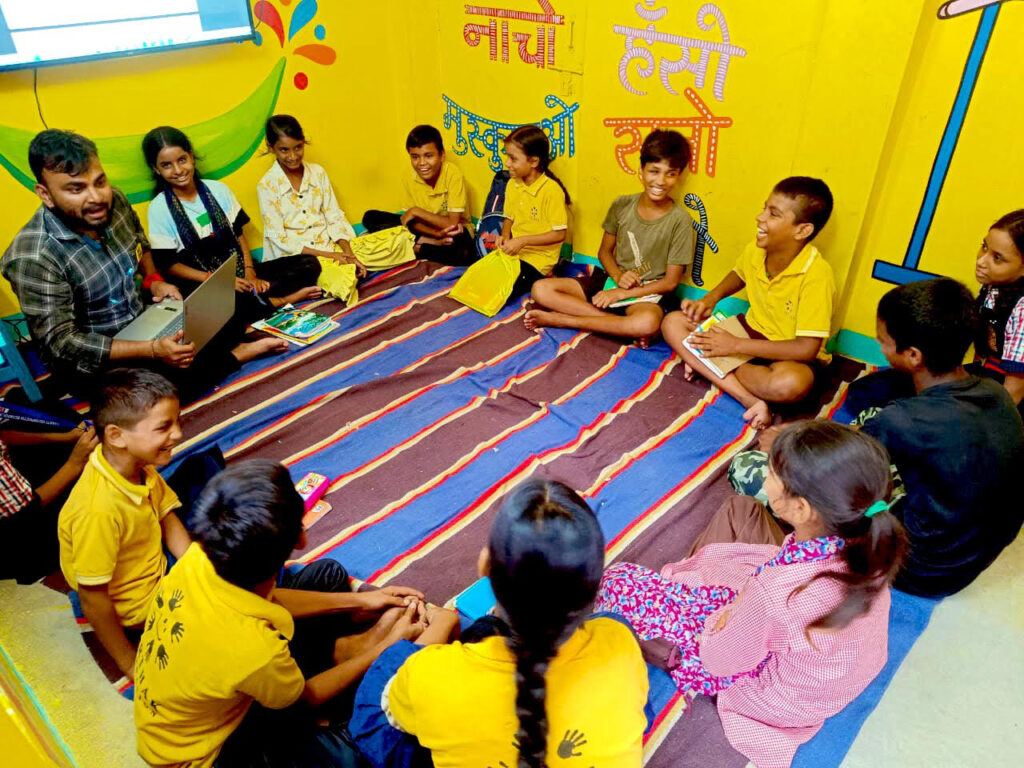Sarthak Yellow Rooms
Home / Sarthak Yellow Rooms
Sarthak Yellow Rooms
“Yellow Rooms are the heart of our work. Situated right in the middle of the community, the Yellow Rooms work for years and become engines of transformation. We think that Yellow Rooms are magic.”
Yellow Rooms is the name of our community based intervention. Each Yellow Rooms setup is located in the heart of slums/villages and has two bright yellow painted rooms and two full time Educators. Yellow Rooms are permanent safe spaces that every child in the community comes to for 3-4 hours every day, all year round for decades, to get classes on school subjects and social emotional well being. The aim of this immersive and long-term project is to turn children from very marginalised backgrounds into complete and well rounded human beings by taking education, financial empowerment, emotional and physical wellness to their doorsteps.
Through Yellow Rooms, we take education and well-being to the doorstep of the children.
Over the years we ensure that almost 100% of the children in the community attend formal schools. We also fund their college education for them to become empowered and provide digital and vocational skilling to older children to make them more employable. The aim being to not just impart cursory literacy, but do more – ensure that the children are equipped to use the tool of education to move themselves and their families out of poverty.
The Yellow Rooms are completely free of cost for the children and the community.
In addition to subjects, the Yellow Rooms curriculum covers topics on values, etiquette and manners, health, hygiene, industry exposure, nutrition, gender awareness and gender equality, general knowledge, animal welfare, communication and etiquette. We also provide nutrition and physical supplies. We also work closely with parents – counselling them, making them aware of government schemes and helping them receive their government entitlements. The impact of Yellow Rooms is life altering.
Sarthak Yellow Rooms Highlights:
1. Long-term Intervention: Operating in the poorest urban slums of UP for over a decade.
2. Safe Spaces for Children: Yellow Rooms as permanent, free-of-cost safe spaces in the heart of slum and rural communities, each setup comprising two bright Yellow Rooms.
3. Age Range: Serving children from 3 to 21 years old.
4. Dedicated Educators: Two permanent Educators, each spending 6 hours daily, year-round.
5. Holistic Development: Focus on turning marginalized children into well-rounded individuals through education, financial empowerment, social and emotional and physical wellness.


6. Comprehensive Approach: Addressing issues beyond education, including substance abuse, hygiene, health, and mental health.
7. STEM Focus: Promoting STEM education from early childhood with a special emphasis on girls, leading to improved learning levels and academic performance.
8. SEPEt Curriculum: Covers Social-Emotional Learning and includes sessions on values, health, gender equality, decision making, financial literacy and more. Uses digital tools, arts, yoga, inspirational talks, soft skill sessions, and workshops to impact children deeply.
9. Nutritional and Wellness Support: Regular provision of fruits and school essentials like uniforms, stationery and clean drinking water.
10. School Inclusion: Ensuring almost 100% school attendance in the community and offering scholarships for private schooling and college education.
11. Gender Equitable Environment: Creating a gender-equitable environment through activities, sessions, workshops, and gender-neutral practices in Yellow Rooms.
12. Life Skills and Sensitivity Towards Nature: Committees of children formed to improve community environment and animal care.
13. Vocational Training: Providing digital and vocational skills to older children for better employability through the Empower Program.
14. Long-term Engagement: Children spend 3 hours daily, 6 days a week, all year-round for 10-15 years.


15. Life-altering Impact: Significant improvements in health, gender awareness, school attendance, hygiene, confidence, outlook to life, communication skills, STEM education and access, school enrolment and overall happiness.
16. Girls’ Education: Marked improvement in girls’ school attendance and a reduction in child marriages.
17. Community Outreach: Observing improvements in parent-child relationships, community cleanliness and access to government schemes.
18. Scale: Running 29 Yellow Rooms in 4 districts, serving around 2900 children, with 56% being girls.

